Our Unseen 1990s Classics Bookend an Outstanding Movie Decade
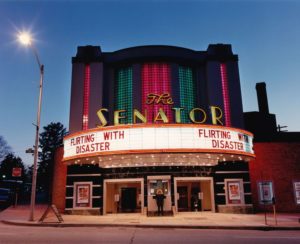
The 90s was a diverging time in cinema. As someone who grew up in the decade and found my budding cinephile voice from the output, it was, to quote Dickens, the best of times and the worst of times.
The battle for the direction of cinema really began in the 90s. Looking at it now, it appears to have been a lopsided war. At the time, there were true artists playing in the studio system and making very challenging films. But at the same time, the Hollywood blockbuster machine was firing on all cylinders. For every Stephen Soderbergh, there was a Michael Bay. For every Paul Thomas Anderson, there was a Roland Emmerich. But the artists really put up a battle and at times, it appeared to be THEIR decade.
A movement that is colloquially referred to as the “video-store directors”, even though only a couple of them really actually worked at video stores, really took off. This broke up what was viewed by some as the film-school movement that was big in the 70s. The idea being that not everyone could afford to go to film school, but everyone still had a voice. In the case of Quentin Tarantino, watching movies all day was all you needed to do. In the case of PT Anderson, dropping out of film school because he once turned in a script from David Mamet as a writing assignment to test the worth of his professor, only to discover the professor not only didn’t recognize it was a Mamet piece but also proceeded to grade the paper with a C letter grade.
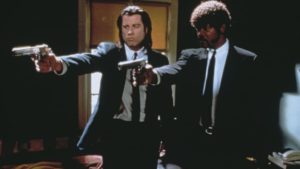
The movement was as interesting as the studio system’s stranglehold on pushing entertainment out was sad. The excitement of the battle of these rebel filmmakers is as fondly looked back at as it is depressing to see what’s happened since. Tarantino was kind of grandfathered into the studio system and still makes bigger films, but there are few that have emerged as the new Tarantino since. PTA has fallen back into making smaller indie films, though still may be brilliant, they don’t have the sprawling budget of his 90s films. Soderbergh now shoots on an iPhone.
On the other hand, the summer blockbuster season is now a 365 affair. But as sad as that may be to some, it was still a thrill to live during the 90s. I do believe no matter when I was born, I was destined to love film. But I truly credit the 90s, and specifically I credit being 20 years old in 1999, quite possibly the greatest year ever in film, as turning me into someone who decided to dedicate my life to film.
– Paul Hibbard

ZekeFilm is 10 years old in 2022! We’re commemorating it with a year-long Film Admissions series wherein each month, we take on a decade (give or take) of cinema, in chronological order. As is always the case with Film Admissions, participants are encouraged to watch a film within that month’s topic that they’ve never seen but have been meaning to. The bigger and more well known the film, the better! Then, together, we share our individual thoughts on our findings.
Magnolia
Directed by Paul Thomas Anderson/1999
by Erik Yates


If Johnny Cash sang about love, god, and murder, it might be said that Paul Thomas Anderson deals in love, religion, and redemption. At least that is the case in his 1999 3-hour opus, Magnolia. From the beginning we are given a sense of the divine as Anderson’s narrator shows us seemingly unrelated stories from the past of people whose lives seem to coincidentally intersect one another. The narrator, however, is skeptical that this is simply random chance, stating that something more providential might be at work. This sets the stage for a series of characters we are about to be introduced to whose lives will somehow overlap one another.
Each character is living around the San Fernando Valley and each one finds themselves facing monumental life crises. From death, to regret, to self-doubt, inflated sense of ego, loss of identity, addiction, adultery, and everything in between, the common desire of all of these individuals is to love or be loved. As one character laments, “I know I have so much love to give”.
Religion is front and center of Anderson’s opus, even if it’s not always recognizable. As has been discussed for over 20 years since its release, the numbers 8 and 2 figure prominently. Though not Anderson’s original intention, Exodus 8:2 seems to bookend this tale, with the same literal plague befalling the San Fernando Valley by the end of his story. Of course, every religious tale needs a prophet, and we hear the entire film in the rap being sung by a young kid who is trying to help Officer Jim understand everything that just happened, but it also tips us off of all that will happen. In the end, we hear all about God and the Devil. As we see these characters spin themselves into deeper and deeper carnality, pain, debt, and hurt, the lines of the young boy’s rap take greater significance, “and he’s running from the devil, but the debt is always gaining, and if he’s worth being hurt, he’s worth bringin’ the pain in, when the sunshine don’t work, the good lord bring the rain in.” And by the end, there is quite the rain, of biblical proportions, telling us that all the sunshine, and letting these people try to fix things themselves, just isn’t helping anyone out.
Of course, spinning out of religion, it is an easy thread to follow that leads to redemption. While it’s not always bestowed on our characters, that is ultimately what they seek. Forgiveness. Restoration. A final word that might fix the hurt and pain and regret so many of them are feeling. Sometimes it comes simply through gazing at oneself through what Elvis Costello sang about in “Deep Dark Truthful Mirror”.
Twenty years after Magnolia, the Ohio group, Over the Rhine, poetically sang in their song “Let You Down”: “…and if a song is worth a thousand prayers, we’ll sing till angels come carry you and all your cares...” . If this is true, then the angel of Magnolia is singer/songwriter Aimee Mann whose songs fill most of the frames of this film with such a beauty, dispensing hope and grace. These are truly the songs becoming prayers until each character joins in the choir crying out for their own redemption in the song, “Wise Up”.
Paul Thomas Anderson is a director that has many films in the “must watch” category. Magnolia is one of those films and it seems a great film to close out the 20th century where there was so much trepidation and fear about what was to come, and what the 21st century would truly bring. The cast is first rate, from top to bottom featuring Tom Cruise, Melora Walters, Philip Baker Hall, Melinda Dillon, William H. Macy, Philip Seymour Hoffman, Julianne Moore, John C. Reilly, and Jason Robards. Many other big names and faces appear as well and each help create the textured layers that make up this must watch film of 1999.
Godzilla
Directed by Roland Emmerich/1998
by Max Foizey
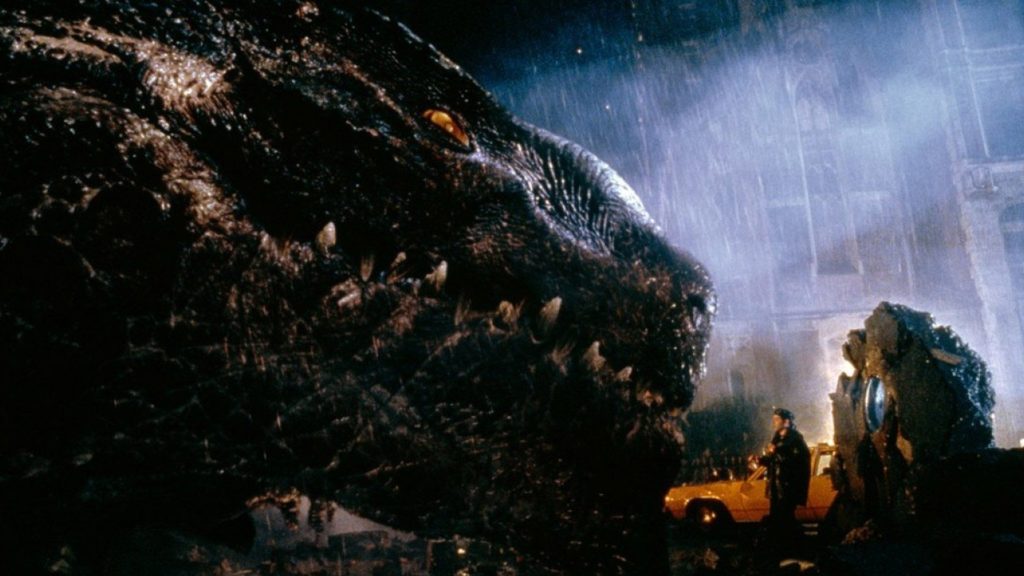
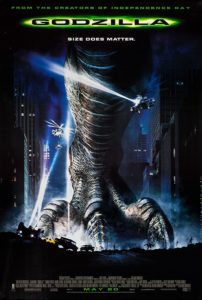
The special effects in 1998’s American take on Godzilla don’t hold up very well, but the same can be said for most Japanese Godzilla films. What can’t be so easily forgiven is the titular creature’s awful redesign, which transforms the iconic kaiju into an overgrown iguana. Worse than the redesign is the monster’s total lack of personality. I guess the filmmakers figured Godzilla should be as devoid of personality as the film’s human characters. The movie acts pretty much like your standard Godzilla film: the scientists warn of impending doom, the elderly talk of monsters, and the military do their best to blow everything up. The script illustrates how much has changed since 1998, when disposable cameras were in vending machines, and sexual harassment was played for laughs.
Nobody watches monster movies for the human characters, but when they are this annoying it’s tough to look past them. Maria Pitillo doesn’t have very much screen presence, Matthew Broderick is all wrong for the lead role in a monster picture, and Jean Reno is playing a Frenchman so stereotypical I thought at one point he would don a beret and say “Ooh La La.” The cast also includes Hank Azaria, Harry Shearer and Nancy Cartwright, three actors who voice characters on The Simpsons, a fact I find kind of strange. Also strange: there is a lot of hat-wearing in this movie. Some of those hats are neat. I found myself focusing on the hats when the jokes and one-liners didn’t land. I found myself focusing on the hats when baby Godzillas show up, in a sad attempt to capitalize on the success of the velociraptors of Jurassic Park.
Director Roland Emmerich and producer Dean Devlin were not fans of the Godzilla monster movies when they signed on to make a version for an American studio. But it seemed like a good match of material and filmmakers, as they had done a big effects film (Stargate) and a big disaster film (Independence Day). Legendary film critics Gene Siskel and Roger Ebert didn’t like either of those films, so Roland and Dean spoofed them by putting two bumbling characters named Roger and Gene in Godzilla, and in one scene, they even bring their thumbs into it. How’s that for petty?
Godzilla was marketed heavily in 1998 and there is plenty of product placement in the film as proof. The soundtrack, featuring Puff Daddy (sampling Led Zeppelin), The Wallflowers (covering David Bowie), and Rage Against the Machine (?), was also huge. With the film being a hit, I’m surprised sequels were not produced. I guess the studio thought it would be an even bigger money maker than it was. Plans for a trilogy were set aside and instead an animated show continuing the story was produced. The studio that created and owns the rights to Godzilla, Toho, has distanced itself from this American version. Their 2001 release Godzilla, Mothra, King Ghidorah: Giant Monsters All Out Attack features dialogue that mentions the events of the American film, with characters saying they did not believe it was the actual Godzilla who attacked the USA. Toho has also since trademarked the iguana version, renaming it “Zilla” to further separate it from the true King of the Monsters.
Dances with Wolves
Directed by Kevin Costner/1990
by Taylor Blake
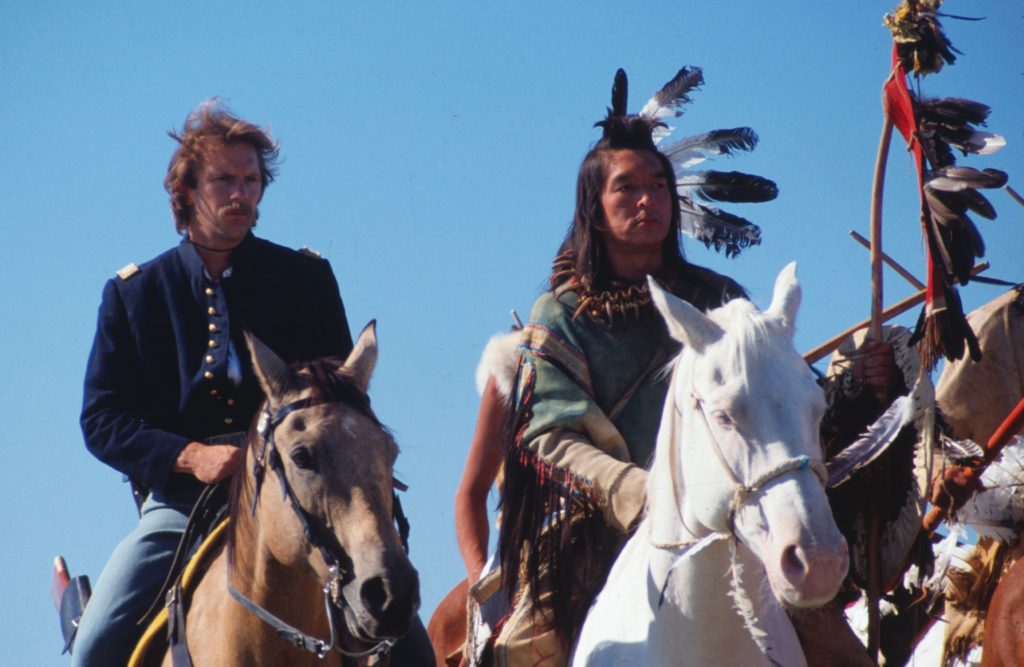
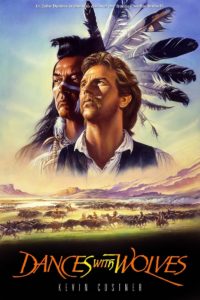
Is the greatest legacy of Dances with Wolves in the 21st century its plot overlaps with Avatar?
It feels silly to say that about a Best Picture winner, but I usually hear it mentioned in passing as an inspiration for that Best Picture nominee that came 19 years later. TBD on whether it will come up in discussion with the release of Avatar: The Way of Water (since Dances didn’t get a sequel, James Cameron probably had to derive his plot from other beloved movies), but I’d like to make the case there’s more to discuss about Kevin Costner’s directorial debut than the films it inspired.
Yes, Dances with Wolves would be made differently today, and there are plenty of good conversations to have about cultural appropriation and who is the best person to tell a story. However, Dances turned out to be a more subversive Revisionist Western than I expected, challenging many of the classic genre tropes built by John Ford, Jimmy Stewart, and John Wayne. For one, the spirit of the United States (government, military, and citizens) is the villain. When we meet Lt. John Dunbar (Costner), his service in the Civil War has driven him to suicide. He survives by chance, and his only hope beyond the war’s death and decay is to move to a remote post out West. The prairies and a friendly wolf revive his spirit, and he builds a relationship with the Sioux tribe nearby.
Lt. John Dunbar isn’t the typical Western hero either. Wayne, Stewart, and other Golden Age leads were sometimes morally complicated but almost always Alpha Males whose rough-and-tumble braun conquered the West, saved their women, and slung guns in the name of justice. The decade leading up this film was dominated by macho guys like Arnold Schwarzenegger, Sylvester Stallone, and Bruce Willis singlehandedly taking down aliens, Communists, and terrorists with machine guns and quips. Beta Male Dunbar, in contrast, journals through his feelings, highlighting the natural beauty around him. He asks questions first and shoots only if necessary. He not only overcomes his cultural prejudice toward Native Americans but makes them the true heroes of his story.
Costner directs in the same style. Golden hour lasts long, and John Barry’s score romanticizes a backdrop Costner obsesses over as much as Dunbar (though I’d argue it only becomes indulgent when he shows off his commitment to his Buns of Steel workouts). In this sentimental style, it’s no wonder Dunbar wants to leave behind the buzzing flies around the corpse of the American dream. Costner insisted on presenting dialogue in Native language, the first film of this size to do so, and he filmed a hunt starring 3500 buffalo so impressive I have no clue how it was accomplished. (Have computers taken some of the magic out of moviemaking? Perhaps we’ll find out in The Way of Water.)
With 7 Oscars, a top 20 box office spot for both 1990 and 1991, and the path he paved for future Best Pictures like Braveheart, Gladiator, and Titanic, it’s surprising Costner has only sat in the director’s chair twice more with 1997’s forgotten flop The Postman and 2003’s just fine Western Open Range. (Not even an episode of Yellowstone?) That’s about to change with Horizon, a Civil War Western story told across several films he’s developing. TBD on whether it will be just as scathing a critique of the American way, but I doubt it will be any less subversive.
Point Break
Directed by Kathryn Bigelow/1991
by Robert Hornak
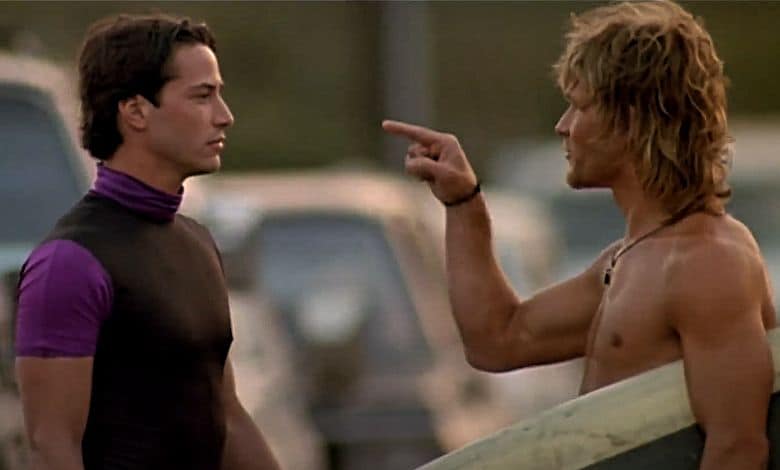
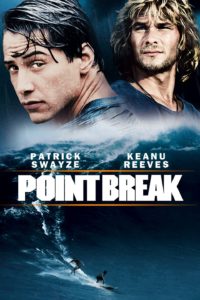
Keanu Reeves is Johnny Utah, from Ohio, an FBI agent on loan to the L.A. office to aid in tracking down some serial bank robbers, who do their work wearing rubber masks of various ex-Presidents, and who our agents deduce are also a tight-knit group of surfers, which Utah must infiltrate undercover before they strike again. But I swear it’s not a comedy. This one’s seeped so deep into the culture I assumed I’d seen it. But no. Also had no idea Kathryn Bigelow directed it, or that her then husband James Cameron produced it. Helps to explain the bigness in every frame, and maybe why it gives off the vibes of being the very last ‘80s movie ever made, with that decade’s Simpson-Bruckheimer patina all over it, unable to completely wash away in the surf.
Two equal and opposite facts of the story are held in tension through the first big chunk of the movie: 1) Utah meets exactly the right random girl to teach him surfing who also happens to be close to a tight-knit group of surfers – led by Bohdi, the charismatically blonde Patrick Swayze, the guy the audience saw in the trailer for the movie – and yet doesn’t allow even an inkling of suspicion to drop into his big, empty head for the entire first hour that they might be the robbers he’s after; and 2) these same meticulous and consistent surfer-thieves – again, who the audience already knows right away are the robbers, because Patrick Swayze – don’t bat an eye at, or do any fact-finding at all on the very cop-like guy suddenly in their ranks who’s using his real name and claims to be a lawyer. So the viewer is ahead of every character on screen for sixty full minutes while Utah goes hanging ten with the enemy and becomes obsessively laser-focused on an entirely different tight-knit group of surfers, who all happen to live in the same house, so that when the inevitable FBI raid goes south, they’re all either injured or mortally, you know, killed, dude. What eventually leads to the hail of bullets and fists at that beachside house is such an unnecessarily long story strand it almost feels like some kind of commentary on the FBI, but the movie doesn’t project real-world weight enough to carry that sort of import. Bottom line, we’re left feeling angry at the ignorance of our main character, and sorry for the poor SOBs caught in the misinformed misfire.
Soon enough, though, the plot finally allows Johnny and Bohdi to know exactly who the other is, and the movie becomes what most who’ve seen it probably remember: a battle of egos between an agent who always gets his man and a bank robbing surfer who will do anything to escape onto the nearest wave. It’s a battle of opposites, during which Bohdi never budges, but Utah (and the audience) does, slowly succumbing to the surfer’s air of confident independence and anti-establishment swagger to the point we eventually start wishing the movie was about him so he can win. Bohdi’s cool and focused, while Utah flails between duty and some mish-mashed, hippy idea of freedom. But more than that, what drives this entire half of the movie is the not-so-understated love that has swelled like a spring tide for each other. It’s a bromance that works itself out in foot chases, fist fights, guns-a-blastin’, and especially in a climactic face-to-face tussle in a shared, plummeting parachute. It all practically screams for a Lancaster-Kerr culmination under the lapping tide. It’s all of Melville’s wit-battling cops and robbers melted down into their obvious, Freudian impulses, and it’s actually a lot of fun to watch them run around not realizing it. Well, Bohdi gets away, months go by, and we fade up on now long-haired Utah sidling up to unsuspecting Bohdi on an Australian shore, where he awaits the once-in-a-lifetime storm that promises the primo-est of waves. For a minute we think Utah still has it in for Bohdi for all that went down, but when the moment comes, and the FBI is circling toward them both, there’s one last look of understanding and love… and Utah lets him go into the waves for that last ride through the tube of no return. Bohdi disappears into the cresting sea; Utah tosses his badge into the sucking surf, a new convert to live-free-or-die, and – we sense – will carry the flame for his greatest foe-meets-zen mind shag for the rest of his life.
Ghost
Directed by Jerry Zucker/1990
by Jim Tudor
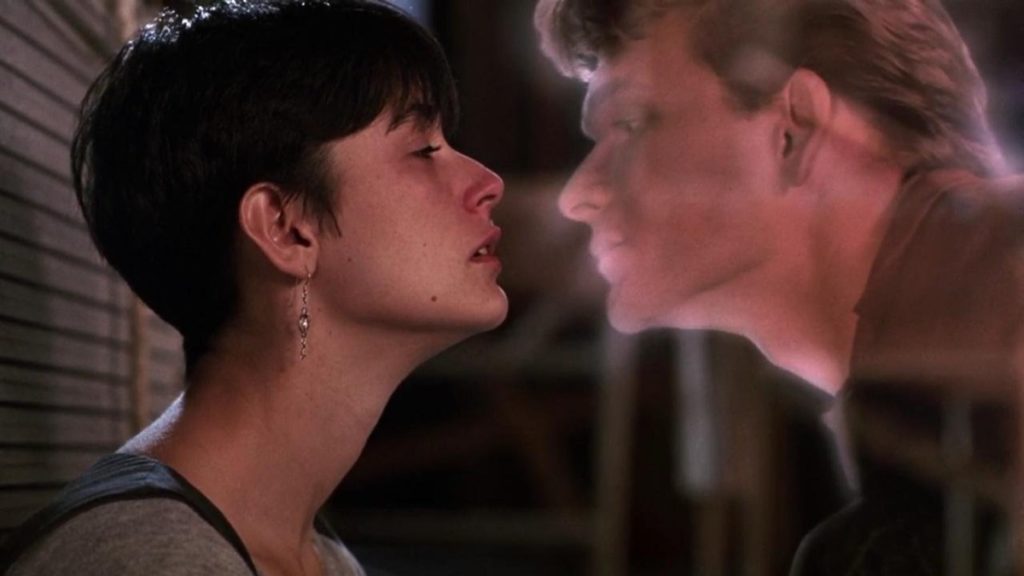
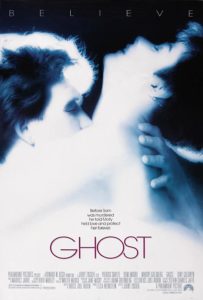
There was a time when it seemed to matter that I hadn’t seen Ghost. People couldn’t believe it. But in this case, not seeing is believing, and I guess I never believed it would matter. For so many, though, Ghost apparently did matter. It’s being the biggest box office hit of 1990 and a multiple Oscar nominee (including a historic win for supporting actress Whoopi Goldberg) were proof enough of its zeitgeist power. But if that weren’t enough, there was the deluge of parodies. You know the scene: Oh, my love…. My darling…. I’ve hungered for your touch…. Patrick Swayze and Demi Moore gettin’ busy on a pottery wheel. It turns out, though, that Ghost isn’t really about that. It’s about money.
Swayze, before he’s so abruptly murdered in an alley in the first fifteen minutes (that’s not a spoiler- he’s the title character), works as a big-time yuppie banker in Manhattan. It’s being 1990 means that the ‘90s haven’t yet kicked in, so he’s going to work dressed as Gordon Gekko in earnest. Like Richard Gere in Pretty Woman that same year, the movie seems to understand that it’s up against a masculinity problem insofar as guys sitting behind desks in starched dress shirts and suspenders talking large dollar amounts doesn’t exactly read as manly-man heartthrob material. Ghost director Jerry Zucker (of Airplane! co-directing fame, looking to spread his wings into mainstream narratives) and screenwriter Bruce Joel Rubin (who somehow won Best Original Screenplay for this) work extra hard to compensate, getting superstar Swayze shirtless whenever possible, and showing him doing physical things like swinging in a window and using a sledgehammer. I guess it worked?
The discussion being had just before Swayze is shot and killed is about Moore’s frustration over when she says, “I love you”, and he habitually replies “Ditto”. So obviously, this whole movie has to be about him working against all odds and the natural order to finally say “I love you” to her. At the climax of the film, he does just that (that is a spoiler- but what are you gonna do about it? I’m noncorporeal to you!), but after all the running around and danger scenes (admittedly, there’s something to be said about wringing tension out of a situation in which the lead character is already dead and can’t be hurt), the big mushy romantic button at the end almost feels like a clever afterthought. Swayze’s weasel coworker (Tony Goldwyn) is bloodthirsty over the $4 million that our protagonist was in the process of dealing with. Soon enough, he’s got Swayze, doing his very best afterlife Bugs Bunny, wisecracking and irritating Goldwyn’s inner Elmer Fudd. Swayze isn’t nearly good enough as an actor to effectively manage this kind of comedy, and frankly, Zucker of all people should know better. (Just think, just a few years prior, he would’ve been first in line to parody the pottery wheel sequence. He did, however, executive produce his brother’s film, Naked Gun 2 1/2: The Smell of Fear the following year. For whatever it’s worth, that film was the first to prominently spoof Ghost).
As evidenced by her Academy Award, Whoopi Goldberg, playing the psychic who’s the only living person who can communicate with Swayze, is actually carrying Ghost. I’m sure this has been a discussion elsewhere previously, but the way the story utilizes her as a struggling Black woman in the service of a wealthy white couple (in this case, willing service) is one of those icky thought trails to venture. I doubt, though, that racial subjugation was anyone’s ambition here. Ultimately, Goldberg’s psychic works to grant Swayze and Moore that final “I love you” moment, and help the film land as the romantic adventure it’s supposed to be. But everything in between is rather rote: chasing the killer, discovering the real bad guy, rerouting the $4 million, et cetra. Though boasting an appropriately sleepy 5am atmosphere throughout, it’s not an especially good movie. It’s no wonder that it’s cultural cache gave up the ghost long ago.


